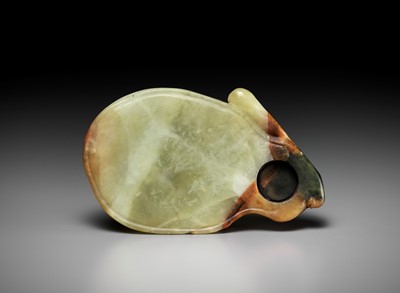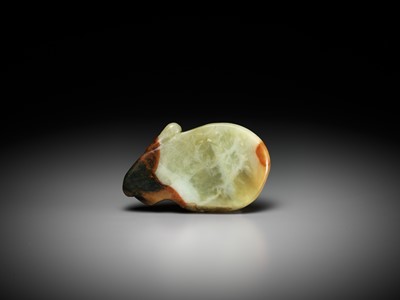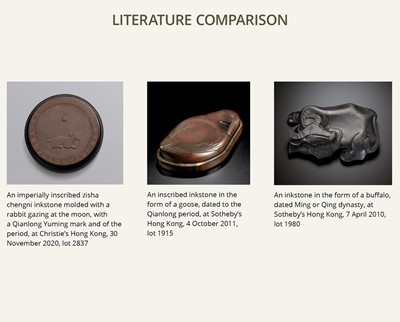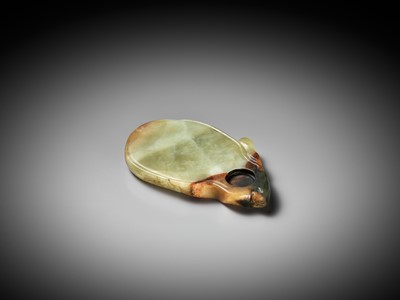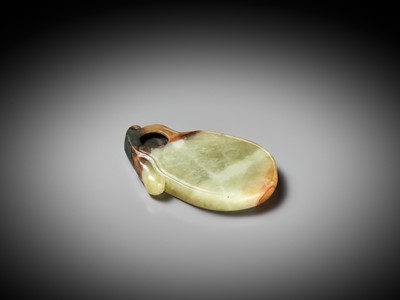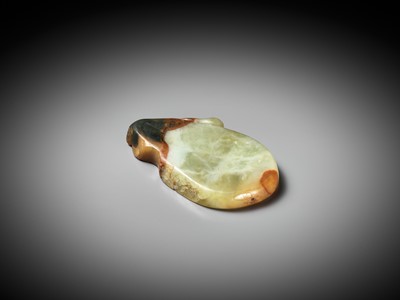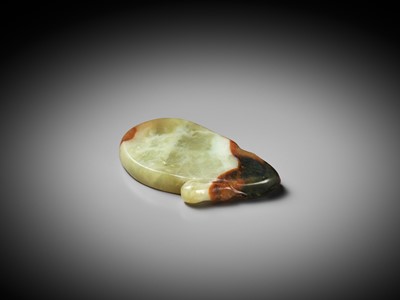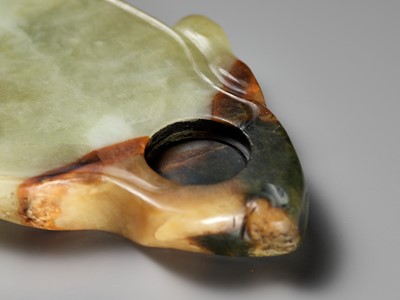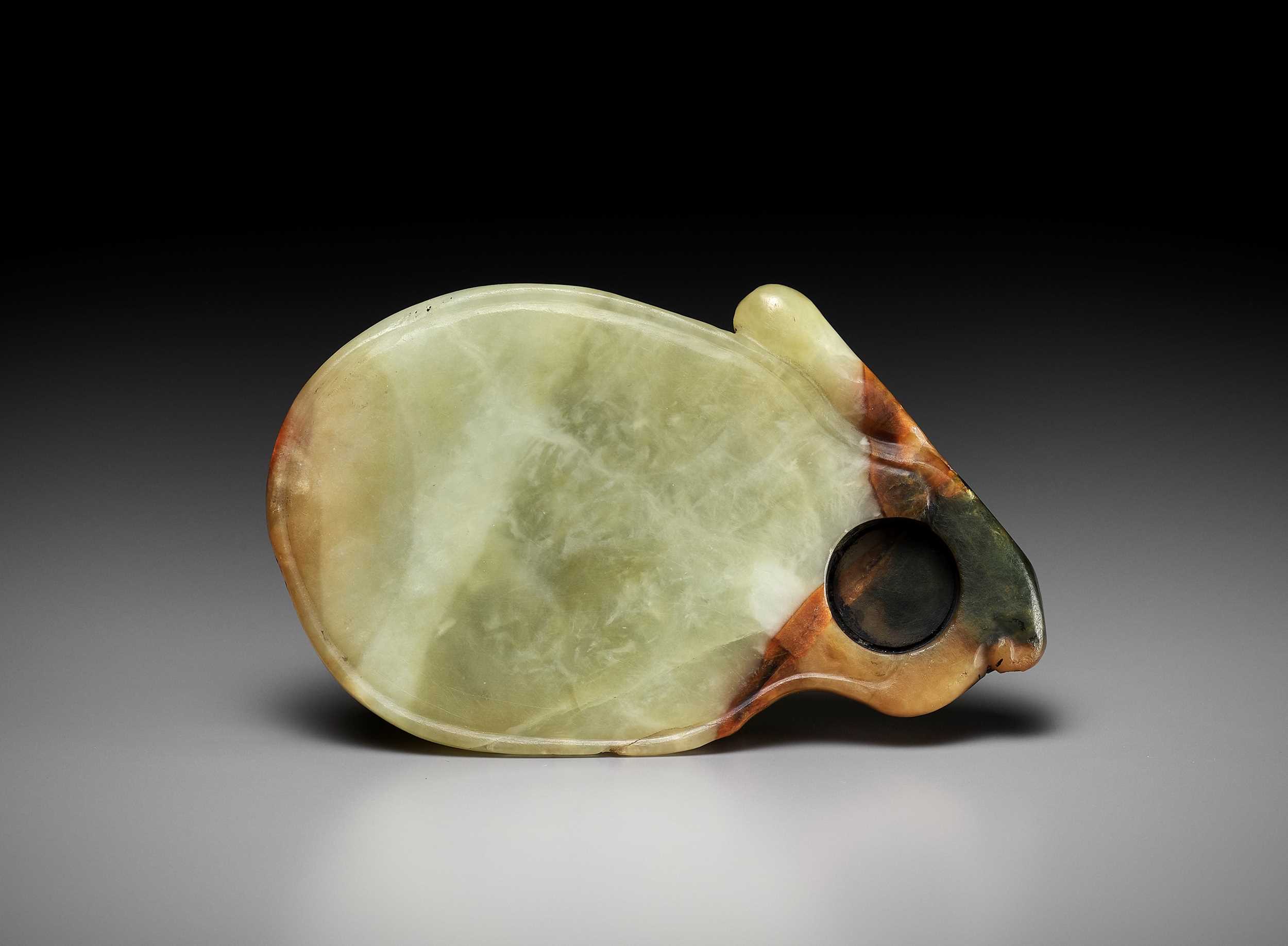29th Sep, 2022 13:00
DAY 1 - TWO-DAY AUCTION - Fine Chinese Art / 中國藝術集珍 / Buddhism & Hinduism
46
A YELLOW AND RUSSET JADE ‘RABBIT’ INKSTONE, EARLY QING DYNASTY
清初黃玉留皮兔形硯臺
Sold for €3,900
including Buyer's Premium
Opinion: Inkstones depicting various animals were made during the Qing dynasty, including pieces of the highest quality made for the Qing court. The present inkstone, being of an abstracted form that still clearly shows the silhouette of a rabbit, with a circular recess (perhaps reminiscent of the moon, with which the rabbit is frequently associated in China) placed exactly where the hare’s eye would be, is a unique and rare example of this group.
China, late 17th - 18th century. Well carved as the silhouette of a rabbit with distinct nose and ears, a circular recess carved in place of the animal’s eye serving as the inkwell. The translucent stone is of a fine and distinct yellow tone with russet and black patches as well as cloudy white inclusions.
Provenance: French trade.
Condition: Very good condition with expected old wear and signs of use including small nicks, light surface scratches, remnants of ink inside the inkwell. Natural fissures and inclusions.
Weight: 231.1 g
Dimensions: Length 12.3 cm
The rabbit is the fourth animal in the Chinese zodiac and considered the luckiest out of all the twelve animals. It symbolizes mercy, elegance, and beauty. Rabbits are also associated with longevity by way of the Moon Hare. In Chinese folklore, the rabbit often is portrayed as a companion of the Moon goddess Chang'e, constantly pounding the elixir of life for her.
Literature comparison:
Compare an imperially inscribed zisha chengni inkstone molded with a rabbit gazing at the moon, with a Qianlong Yuming mark and of the period, at Christie’s Hong Kong, 30 November 2020, lot 2837. Compare an inscribed inkstone in the form of a goose, dated to the Qianlong period, at Sotheby’s Hong Kong, 4 October 2011, lot 1915. Compare an inkstone in the form of a buffalo, dated Ming or Qing dynasty, at Sotheby’s Hong Kong, 7 April 2010, lot 1980.
清初黃玉留皮兔形硯臺
中國,十七世紀末至十八世紀。兔形硯臺,線條清晰分明,在眼睛的地方有一個圓形凹槽。這顆半透明石料呈溫潤的黃色,帶有赤褐色和黑色斑塊以及白色絮狀物。
專家注釋:動物形狀的硯台出現在清代,其中包括御製硯台。這件硯台以簡潔的形式清晰地顯示出兔子的輪廓,在兔子眼睛所在的位置有一個圓形的凹槽(讓人想起月亮,兔子經常與月亮聯繫在一起)。
來源:法國古玩交易。
品相:品相極好,有磨損和使用跡象,包括小刻痕、輕微的劃痕,有墨水殘留。自然裂縫和内沁。
重量:231.1 克
尺寸:長12.3 厘米
兔子在中國十二生肖中排行第四,它象徵著慈悲和優雅。兔子因爲月兔神話,同時也寓意著長壽。在中國民間傳說中,兔子是月神嫦娥的伴侶,為她搗長生不老藥。
文獻比較:
比較一件乾隆御銘的紫砂澄泥硯,飾有兔凝月,見香港佳士得,2020年11月30日,lot 2837。比較一件乾隆時期鵝形硯臺,見香港蘇富比,2011年10月4日,lot 1915。比較一件明或清代水牛形硯臺,見香港蘇富比,2010年4月7日,lot 1980。
Opinion: Inkstones depicting various animals were made during the Qing dynasty, including pieces of the highest quality made for the Qing court. The present inkstone, being of an abstracted form that still clearly shows the silhouette of a rabbit, with a circular recess (perhaps reminiscent of the moon, with which the rabbit is frequently associated in China) placed exactly where the hare’s eye would be, is a unique and rare example of this group.
China, late 17th - 18th century. Well carved as the silhouette of a rabbit with distinct nose and ears, a circular recess carved in place of the animal’s eye serving as the inkwell. The translucent stone is of a fine and distinct yellow tone with russet and black patches as well as cloudy white inclusions.
Provenance: French trade.
Condition: Very good condition with expected old wear and signs of use including small nicks, light surface scratches, remnants of ink inside the inkwell. Natural fissures and inclusions.
Weight: 231.1 g
Dimensions: Length 12.3 cm
The rabbit is the fourth animal in the Chinese zodiac and considered the luckiest out of all the twelve animals. It symbolizes mercy, elegance, and beauty. Rabbits are also associated with longevity by way of the Moon Hare. In Chinese folklore, the rabbit often is portrayed as a companion of the Moon goddess Chang'e, constantly pounding the elixir of life for her.
Literature comparison:
Compare an imperially inscribed zisha chengni inkstone molded with a rabbit gazing at the moon, with a Qianlong Yuming mark and of the period, at Christie’s Hong Kong, 30 November 2020, lot 2837. Compare an inscribed inkstone in the form of a goose, dated to the Qianlong period, at Sotheby’s Hong Kong, 4 October 2011, lot 1915. Compare an inkstone in the form of a buffalo, dated Ming or Qing dynasty, at Sotheby’s Hong Kong, 7 April 2010, lot 1980.
清初黃玉留皮兔形硯臺
中國,十七世紀末至十八世紀。兔形硯臺,線條清晰分明,在眼睛的地方有一個圓形凹槽。這顆半透明石料呈溫潤的黃色,帶有赤褐色和黑色斑塊以及白色絮狀物。
專家注釋:動物形狀的硯台出現在清代,其中包括御製硯台。這件硯台以簡潔的形式清晰地顯示出兔子的輪廓,在兔子眼睛所在的位置有一個圓形的凹槽(讓人想起月亮,兔子經常與月亮聯繫在一起)。
來源:法國古玩交易。
品相:品相極好,有磨損和使用跡象,包括小刻痕、輕微的劃痕,有墨水殘留。自然裂縫和内沁。
重量:231.1 克
尺寸:長12.3 厘米
兔子在中國十二生肖中排行第四,它象徵著慈悲和優雅。兔子因爲月兔神話,同時也寓意著長壽。在中國民間傳說中,兔子是月神嫦娥的伴侶,為她搗長生不老藥。
文獻比較:
比較一件乾隆御銘的紫砂澄泥硯,飾有兔凝月,見香港佳士得,2020年11月30日,lot 2837。比較一件乾隆時期鵝形硯臺,見香港蘇富比,2011年10月4日,lot 1915。比較一件明或清代水牛形硯臺,見香港蘇富比,2010年4月7日,lot 1980。
Zacke Live Online Bidding
Our online bidding platform makes it easier than ever to bid in our auctions! When you bid through our website, you can take advantage of our premium buyer's terms without incurring any additional online bidding surcharges.
To bid live online, you'll need to create an online account. Once your account is created and your identity is verified, you can register to bid in an auction up to 12 hours before the auction begins.
Intended Spend and Bid Limits
When you register to bid in an online auction, you will need to share your intended maximum spending budget for the auction. We will then review your intended spend and set a bid limit for you. Once you have pre-registered for a live online auction, you can see your intended spend and bid limit by going to 'Account Settings' and clicking on 'Live Bidding Registrations'.
Your bid limit will be the maximum amount you can bid during the auction. Your bid limit is for the hammer price and is not affected by the buyer’s premium and VAT. For example, if you have a bid limit of €1,000 and place two winning bids for €300 and €200, then you will only be able to bid €500 for the rest of the auction. If you try to place a bid that is higher than €500, you will not be able to do so.
Online Absentee and Telephone Bids
You can now leave absentee and telephone bids on our website!
Absentee Bidding
Once you've created an account and your identity is verified, you can leave your absentee bid directly on the lot page. We will contact you when your bids have been confirmed.
Telephone Bidding
Once you've created an account and your identity is verified, you can leave telephone bids online. We will contact you when your bids have been confirmed.
Classic Absentee and Telephone Bidding Form
You can still submit absentee and telephone bids by email or fax if you prefer. Simply fill out the Absentee Bidding/Telephone bidding form and return it to us by email at office@zacke.at or by fax at +43 (1) 532 04 52 20. You can download the PDF from our Upcoming Auctions page.
How-To Guides
How to Create Your Personal Zacke Account
How to Register to Bid on Zacke Live
How to Leave Absentee Bids Online
How to Leave Telephone Bids Online
中文版本的操作指南
创建新账号
注册Zacke Live在线直播竞拍(免平台费)
缺席投标和电话投标
Third-Party Bidding
We partner with best-in-class third-party partners to make it easy for you to bid online in the channel of your choice. Please note that if you bid with one of our third-party online partners, then there will be a live bidding surcharge on top of your final purchase price. You can find all of our fees here. Here's a full list of our third-party partners:
- 51 Bid Live
- EpaiLive
- ArtFoxLive
- Invaluable
- LiveAuctioneers
- the-saleroom
- lot-tissimo
- Drouot
Please note that we place different auctions on different platforms. For example, in general, we only place Chinese art auctions on 51 Bid Live.
Bidding in Person
You must register to bid in person and will be assigned a paddle at the auction. Please contact us at office@zacke.at or +43 (1) 532 04 52 for the latest local health and safety guidelines.
